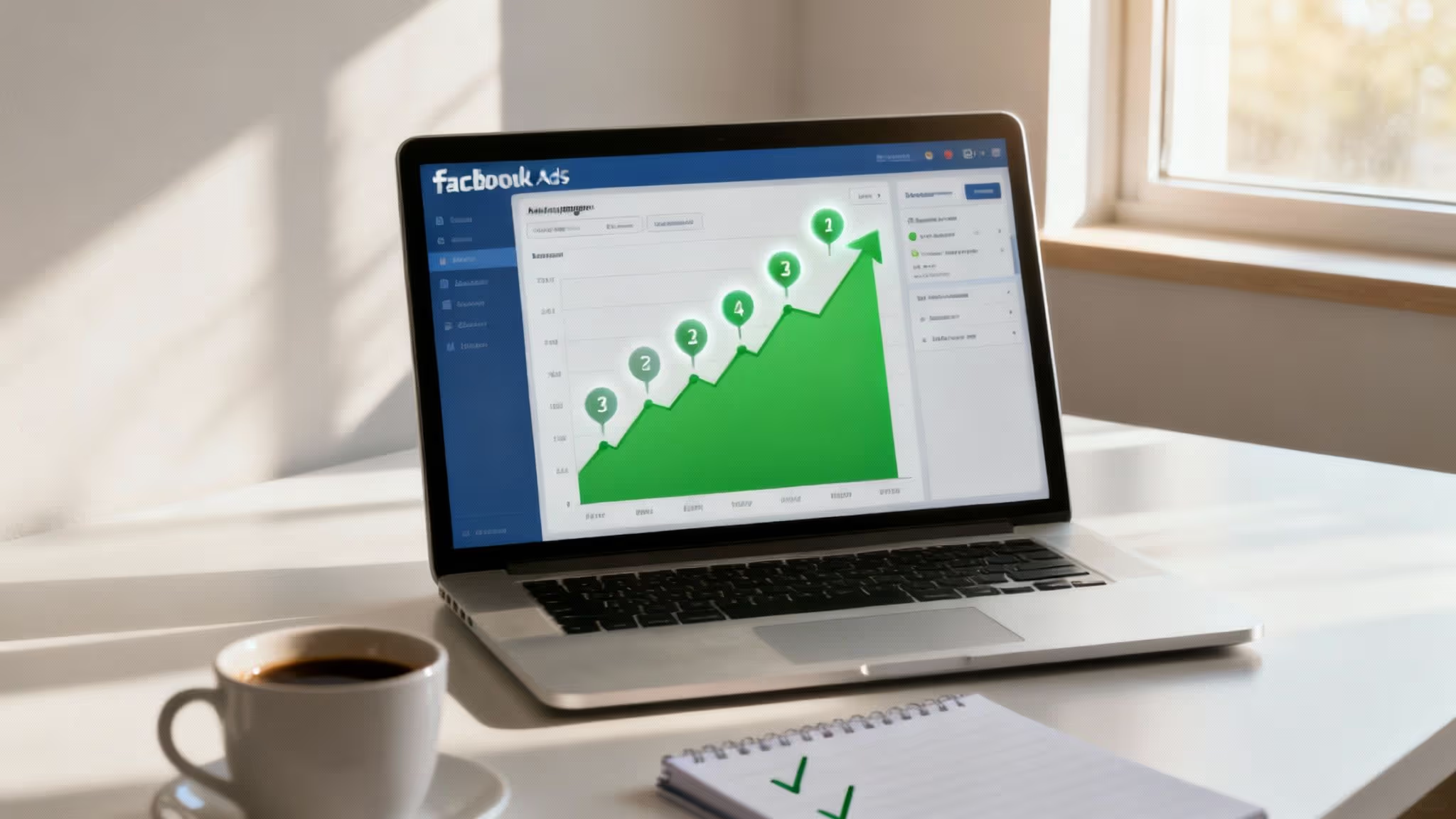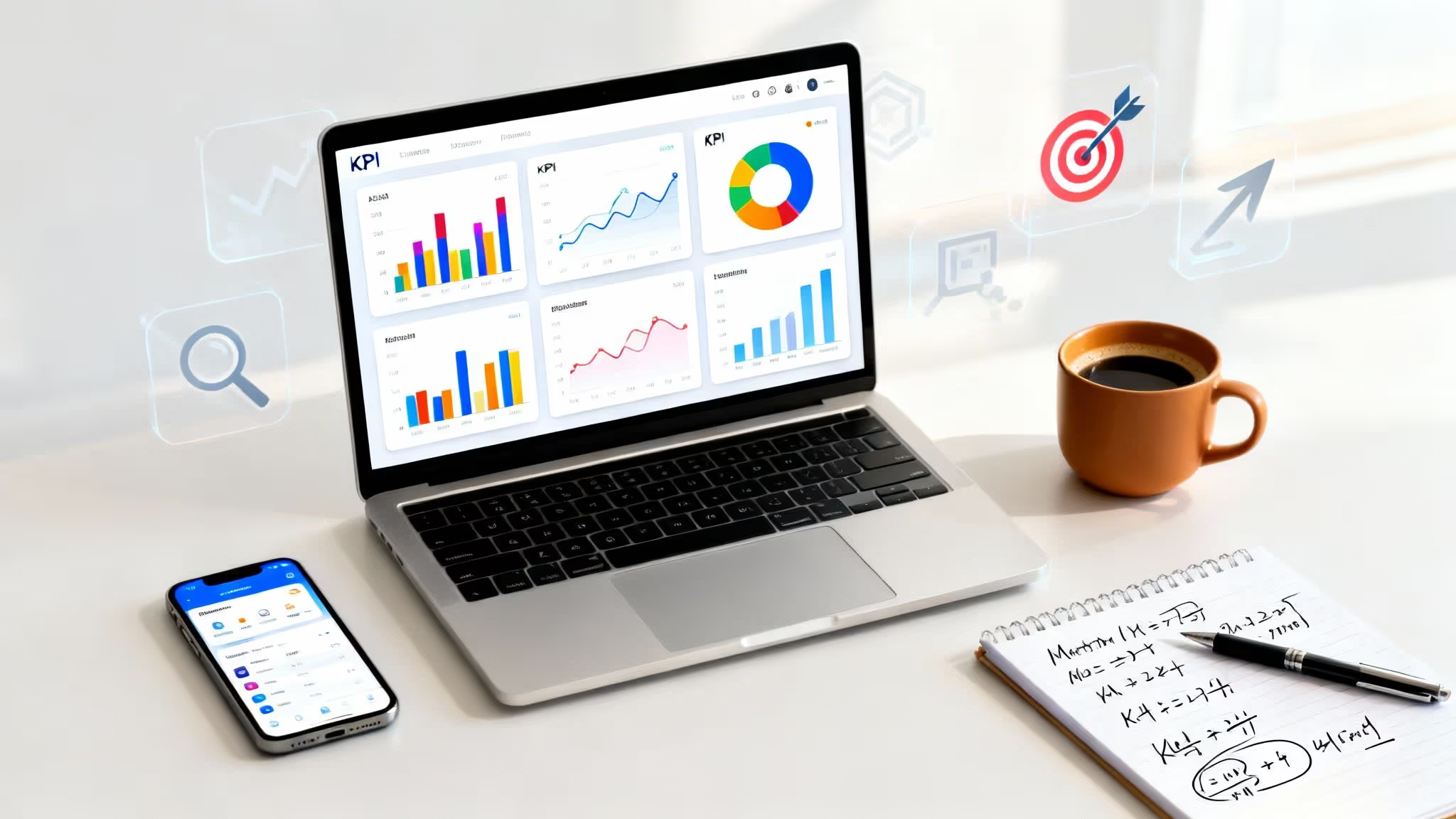In the dynamic world of digital advertising, mastering Facebook requires more than just a budget; it demands a sophisticated, data-driven strategy. As the platform's algorithm evolves and privacy considerations shift how campaigns are measured, outdated tactics like boosting posts and running generic ads no longer deliver the same impact. For B2B and professional services brands, the challenge is even greater: cutting through consumer-focused noise to reach high-value decision-makers effectively and profitably.
This guide goes beyond the basics, offering a definitive list of the 10 most critical Facebook Ads best practices you need to implement for maximum ROI. We'll explore actionable strategies that address the unique challenges B2B marketers face, from advanced audience segmentation to crafting ad creative that resonates with a professional audience.
Whether you're aiming to refine your targeting, develop scroll-stopping creative, or optimize for genuine profitability, these insights will equip you to turn ad spend into measurable business growth. We'll provide a balanced perspective, exploring not just what to do, but why it works and how to avoid common pitfalls that drain budgets. Consider this your playbook for building a high-performance Facebook advertising engine that acquires clients, generates leads, and drives revenue. Let's explore the essential practices that will define success on the platform.
1. Define Clear Campaign Objectives and Use the Right Campaign Goal
Selecting the correct campaign objective is the foundational first step for any successful Facebook Ads campaign. This choice is more than a label; it directly instructs Meta’s powerful algorithm on your desired outcome. The platform then optimizes ad delivery to find users within your target audience who are most likely to perform that specific action, influencing everything from bidding strategy to ad placements. This is one of the most critical Facebook ads best practices because a mismatch between your business goal and your campaign objective will lead to wasted ad spend and subpar results.
For example, choosing "Traffic" when you want sales will result in Facebook finding people who click links, not necessarily people who buy. Conversely, an e-commerce brand that switched from a 'Traffic' objective to a 'Conversions' objective (optimized for the 'Purchase' event) saw its return on ad spend (ROAS) increase by a staggering 340%.
Aligning Objectives to Your Marketing Funnel
Your chosen objective should mirror the prospect's stage in your marketing funnel. This strategic alignment ensures you're delivering the right message to the right person at the right time.
- Top of Funnel (Awareness): Use objectives like Brand Awareness or Reach to introduce your B2B service or SaaS platform to a cold audience. The goal here is broad exposure, not immediate action.
- Middle of Funnel (Consideration): Objectives like Traffic, Lead Generation, or Engagement work well for audiences who are aware of you but not yet ready to commit. For instance, a SaaS company used the 'Lead Generation' objective with instant forms and achieved a 62% lower cost per lead compared to directing users to an external landing page.
- Bottom of Funnel (Conversion): Use Conversions or Sales for warm or hot audiences ready to make a decision. This requires a properly installed Meta Pixel to track actions like 'Schedule a Demo' or 'Start Trial'.
The following diagram illustrates the hierarchical relationship between these core marketing stages and their corresponding campaign objectives.

This hierarchy clarifies how your primary business goal dictates the campaign type, ensuring your advertising efforts are strategically sound from the start. Understanding how Facebook's ad auction and delivery system works will further enhance your grasp of this process.
2. Implement Proper Audience Targeting and Segmentation
Effective audience targeting is the engine of a high-performing ad campaign. Instead of broadcasting your message to everyone, strategic segmentation allows you to deliver highly relevant ads to specific user groups based on their demographics, interests, behaviors, and your own business data. This is a cornerstone of Facebook ads best practices because it ensures your budget is spent reaching users most likely to become valuable clients, dramatically improving efficiency and ROI.
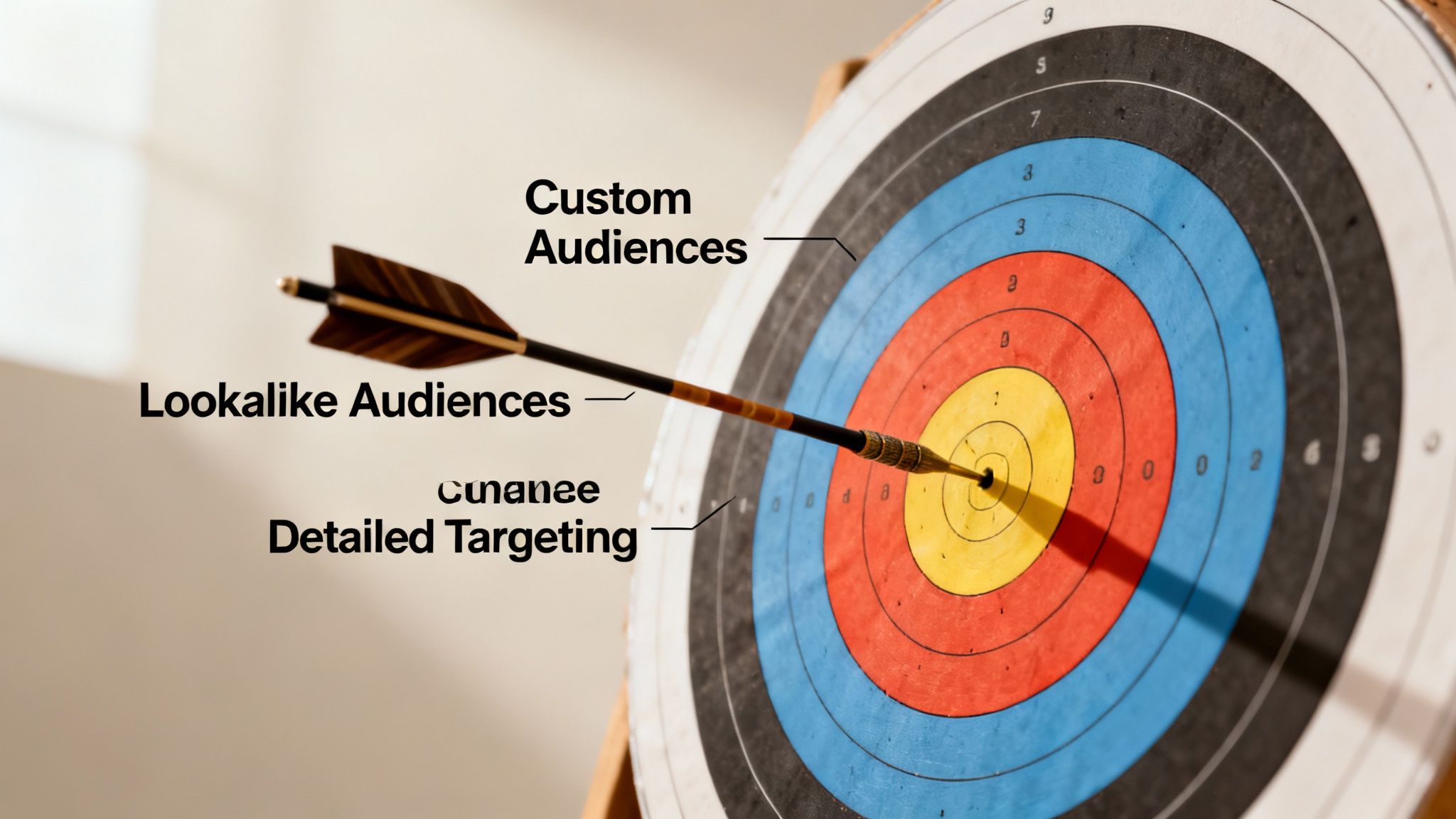
For instance, a B2B software company used a 1% Lookalike Audience based on its existing trial signups and generated new leads at a 58% lower cost than its previous interest-based targeting campaigns. Similarly, a fitness app improved its customer acquisition cost (CAC) by excluding existing subscribers from its acquisition campaigns, which reduced wasted ad impressions by 23%. These examples highlight how precision targeting directly impacts the bottom line.
Key Audience Types and How to Use Them
Facebook’s powerful targeting options can be categorized into three core types, each serving a different strategic purpose for B2B and professional services firms.
- Custom Audiences: These are your warmest audiences, built from your own data sources like a customer list, website visitors (via the Meta Pixel), or people who have engaged with your Facebook or Instagram content. Start here for retargeting campaigns to re-engage prospects who have already shown interest.
- Lookalike Audiences: This tool finds new people on Facebook who are similar to your best existing customers. Create a Lookalike Audience from a high-value source, like a list of clients who purchased your top-tier service package, to find qualified cold prospects at scale.
- Detailed Targeting (Saved Audiences): This allows you to build audiences from scratch based on user data like demographics, interests (e.g., "software development"), and behaviors (e.g., "B2B decision-makers"). Use this to test new cold audiences or to layer on top of Lookalike audiences for greater specificity.
Properly defining who you are trying to reach is the first step toward effective segmentation. You can get more insights on how to identify your target audience on twelverays.agency to build a solid foundation for your campaigns.
3. Create Mobile-First, Scroll-Stopping Creative
With the vast majority of users accessing Facebook on a mobile device, creating ads designed specifically for vertical screens is non-negotiable. In a crowded feed where users scroll quickly, your ad has less than two seconds to capture attention. This makes mobile-first, scroll-stopping creative one of the most vital Facebook ads best practices. Ads that fail to engage instantly are scrolled past and forgotten, wasting your budget and opportunity. The key is to design visuals and messaging that are immediate, impactful, and easily understood without sound.
For instance, Gymshark's use of authentic, user-generated content in a 9:16 vertical format outperformed their polished, professional photoshoots by 2.3x in engagement. Similarly, Duolingo’s meme-style ads featuring their owl mascot in unexpected situations generated a 65% higher click-through rate (CTR) than their traditional product-focused imagery. These examples prove that creative built for the platform's native experience wins.
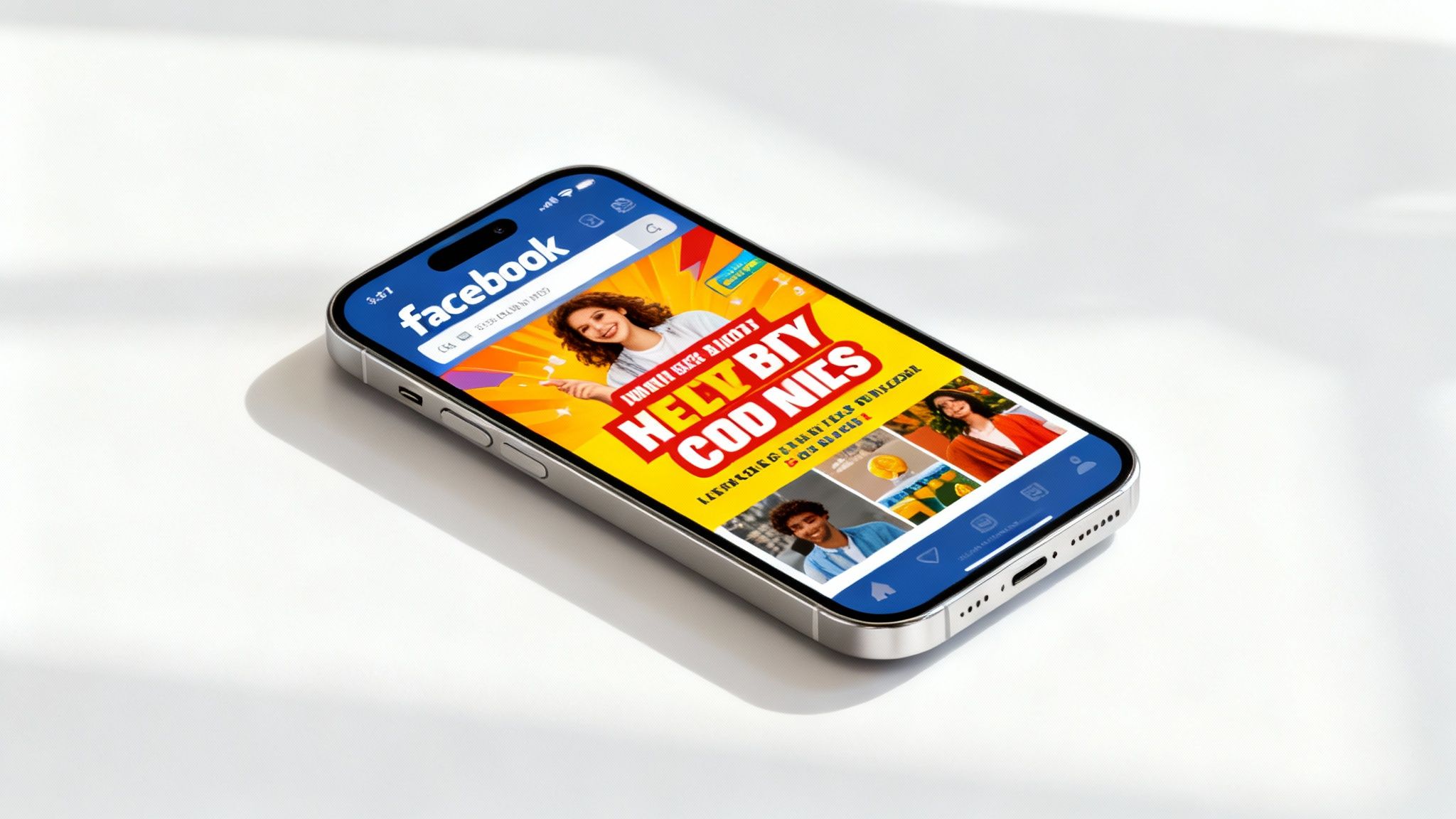
Actionable Tips for High-Impact Creative
To stop the scroll and hold attention, your creative must be intentionally disruptive and value-driven from the very first frame. This approach ensures your message breaks through the noise.
- Lead with the Payoff: Don't build up to your value proposition. Show the benefit or the most compelling part of your offer in the first 3 seconds. For a B2B service, this could be a statistic showing client results or a direct statement addressing a major pain point.
- Use Pattern Interrupts: Employ unexpected visuals, jarring cuts, or high-contrast colors to break the user's scrolling pattern. This visual disruption forces a moment of pause, giving your message a chance to land.
- Design for Sound-Off Viewing: Since a majority of videos on Facebook are watched without sound, use bold text overlays and captions to convey your entire message visually. Keep text concise and ensure it complements the on-screen action.
- Embrace Native Formats: Create content that feels organic to the Facebook feed rather than like a polished television commercial. Using user-generated content (UGC) or simple, direct-to-camera videos can significantly boost authenticity and engagement.
The following video from Harmon Brothers, the agency behind viral ads for brands like Purple and Squatty Potty, breaks down the formula for creating compelling video ads that capture and hold attention.
By implementing these creative strategies, you move from simply showing ads to delivering experiences that resonate with mobile users, leading directly to better campaign performance and higher return on ad spend.
4. Test Multiple Ad Variations Through Structured A/B Testing
Systematic testing is the engine of Facebook advertising optimization. Instead of relying on assumptions, structured A/B testing allows you to make data-driven decisions about every element of your campaign, from creative and copy to audiences and placements. The core principle is to isolate and test one variable at a time to determine what truly drives performance. This iterative process of testing, learning, and implementing is one of the most crucial Facebook ads best practices for achieving compounding improvements and maximizing your return on investment.
For instance, a SaaS company tested video testimonials against product demo videos. The testimonials generated 2.1x more trial signups despite having lower overall view rates, revealing that authenticity resonated more with their bottom-of-funnel audience. Similarly, an e-commerce brand found that testing five different headline variations led to a 47% increase in conversion rate for their benefit-focused headline over a feature-focused one.
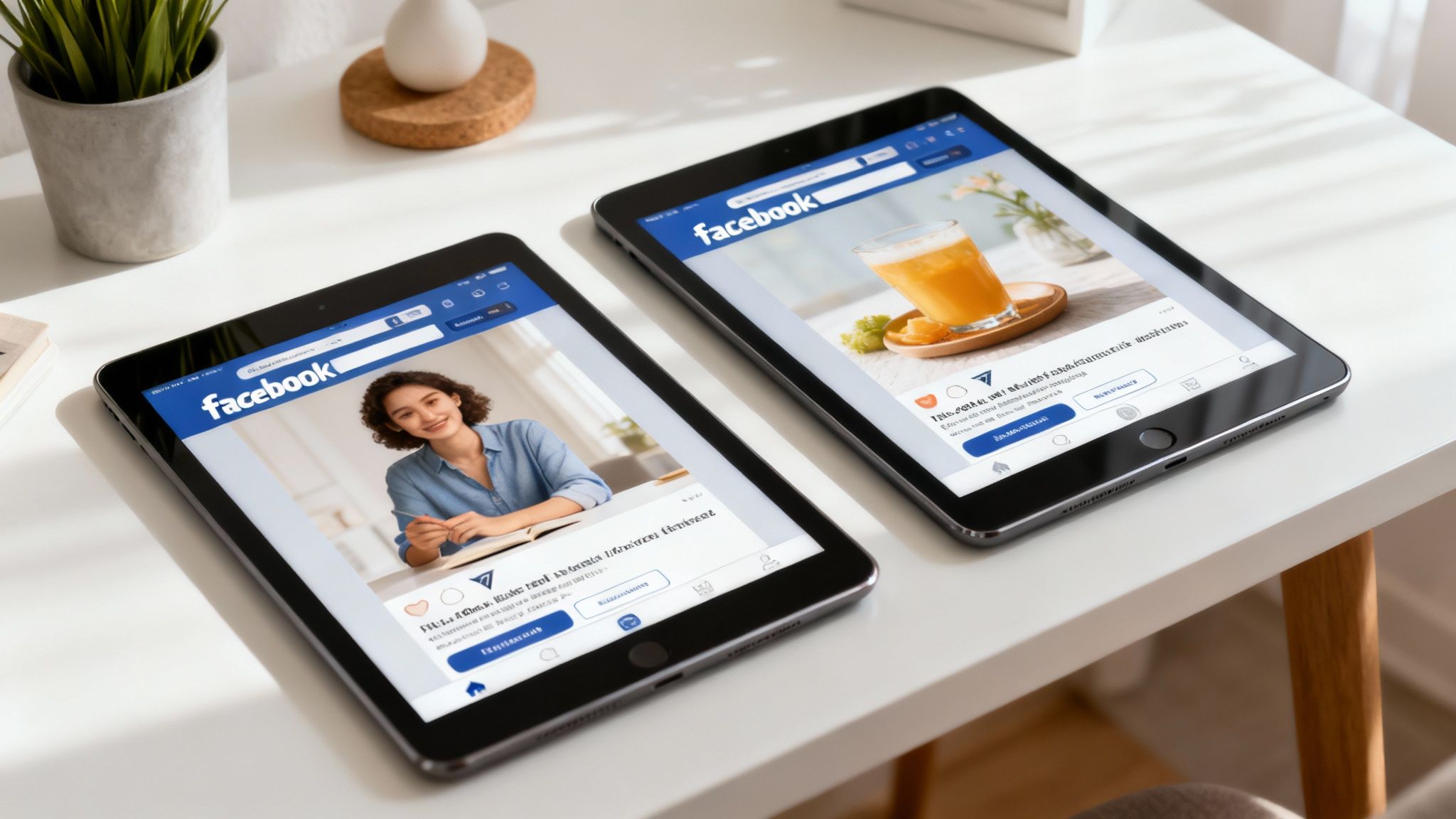
Implementing a Methodical Testing Framework
To get clean, actionable results, your testing process must be disciplined. The goal is to create a controlled experiment where you can confidently attribute performance changes to a specific variable. This approach removes guesswork and builds a library of insights unique to your business.
- Isolate One Variable: The golden rule of A/B testing is to change only one element at a time. Test your creative (image vs. video), your primary text, your headline, or your audience, but never multiple elements simultaneously.
- Establish Statistical Significance: Run tests long enough to gather sufficient data. A common benchmark is a minimum of 3-7 days or until each ad variation has achieved at least 50 conversions. This prevents making premature decisions based on random fluctuations.
- Start with Big Swings: Begin by testing fundamentally different concepts rather than minor tweaks. For example, test a video testimonial against a static image of your software's UI, or a long-form copy against a short, punchy version. Once you find a winning concept, you can then micro-optimize elements like the headline or call-to-action.
- Document Everything: Maintain a log of all tests, including your hypothesis, the variable tested, the results, and your key takeaways. This "knowledge base" prevents you from repeating tests and accelerates your team's learning curve over time.
By embracing a continuous testing culture, you turn your ad account into a learning machine. This methodical approach ensures your campaign performance doesn't just improve; it evolves.
5. Leverage the Facebook Pixel and Conversion API for Accurate Tracking
Accurate data tracking is the bedrock of profitable advertising, and for Meta, this relies on a dual-tool approach: the Meta Pixel and the Conversion API (CAPI). The Pixel is a small piece of code on your website that tracks user actions, while CAPI sends conversion data directly from your server to Meta's. Using them together creates a resilient tracking system that circumvents browser-based limitations from privacy updates like iOS 14.5. This synergy is one of the most vital Facebook ads best practices because it ensures the algorithm receives the high-quality data it needs to optimize ad delivery and accurately attribute results.
Neglecting this setup means you're operating with incomplete information, leading to flawed optimization and an inaccurate understanding of your campaign performance. For instance, a lead generation company that implemented CAPI alongside its pixel saw a 28% recovery in reported conversions, which directly improved its ability to optimize for high-quality leads and lower its cost per acquisition.
Implementing a Redundant and Reliable Tracking System
A comprehensive tracking setup ensures you capture user actions across your entire digital ecosystem, from initial website visits to final conversions. This allows you to build powerful retargeting audiences and provide the algorithm with the feedback it needs to find more people like your best customers.
- Install the Pixel Everywhere: The Meta Pixel should be installed on every single page of your website, not just your primary landing pages. This provides a complete picture of user behavior and helps build more effective custom audiences.
- Layer the Conversion API (CAPI): CAPI is not a replacement for the pixel; it's a powerful supplement. It sends data server-to-server, making it more reliable than the browser-dependent pixel. This redundancy is key to overcoming data loss from ad blockers and privacy settings.
- Prioritize Standard and Custom Events: Set up all standard events relevant to your business, such as 'Lead', 'CompleteRegistration', or 'Schedule'. For B2B or SaaS funnels, use custom events to track key actions like 'Demo_Request_Step2' or 'Pricing_Page_View' to optimize for more qualified prospects.
- Enhance Data with Advanced Matching: Enable Advanced Matching to securely send hashed customer data (like email addresses and phone numbers) with your events. This helps Meta attribute conversions more accurately, even when cookies are blocked, significantly improving your reported ROAS.
By implementing both the Pixel and CAPI, you're not just tracking; you're future-proofing your advertising measurement. This robust data foundation enables better decision-making, more efficient ad spend, and ultimately, superior campaign results.
6. Use Campaign Budget Optimization (CBO) and Proper Budget Allocation
Leveraging Campaign Budget Optimization (CBO) is a critical step in scaling your advertising efforts efficiently. Instead of manually setting and adjusting budgets for each ad set, CBO allows Meta's algorithm to automatically distribute your total campaign budget in real-time. It allocates more spend to the ad sets that are generating the best results, maximizing your return without constant manual intervention. This is one of the most powerful Facebook ads best practices because it lets data, not guesswork, drive your budget allocation and improve performance.
For example, a service-based business running a promotional campaign with CBO noticed the budget automatically shifting to ad sets targeting specific times of day when user intent was highest. This dynamic allocation maximized conversions during peak periods and led to a 28% increase in qualified leads compared to their previous ad set budget approach. This automated efficiency is key to unlocking better ROI.
Implementing CBO and Smart Budgeting
Properly implementing CBO involves more than just toggling a switch; it requires a strategic approach to budgeting and campaign structure to give the algorithm the best chance to succeed.
- Set an Adequate Budget: To exit the learning phase and allow CBO to optimize effectively, provide a sufficient budget. A common best practice is to set a daily budget that allows for at least 50 conversions per week to provide the algorithm enough data.
- Scale Methodically: When scaling a successful CBO campaign, avoid drastic changes. Increase the budget by no more than 20-30% every few days to prevent the algorithm from re-entering the volatile learning phase, which can disrupt performance.
- Use Ad Set Spending Limits Sparingly: While you can set minimum or maximum spend limits on ad sets within a CBO campaign, do so with caution. Overusing them can restrict the algorithm's ability to allocate funds to the true top performers, defeating the purpose of CBO. Use them primarily to ensure a new, unproven audience gets a fair test.
- Structure for Success: Start with 2 to 5 ad sets per CBO campaign. Too few limits the algorithm's options, while too many can dilute the budget and prevent any single ad set from gaining enough data to optimize properly. This focused structure is vital for B2B client acquisition where audience pools may be smaller.
By entrusting budget allocation to Meta's machine learning, you free up valuable time to focus on higher-level strategy, like creative development and offer optimization. You can learn more about best practices to boost your ecommerce PPC ROI on twelverays.agency, with many principles applying directly to B2B campaigns.
7. Write Compelling Copy with Clear Value Propositions and CTAs
Your visuals may stop the scroll, but your ad copy is what communicates the "why" and drives the click. Effective Facebook ad copy is a masterclass in direct response marketing, focusing on clear benefits, addressing specific pain points, and guiding the user to a single, obvious next step. This is one of the most critical Facebook ads best practices because even the best targeting and creative will fail if your message doesn't resonate or is unclear about the value you provide.
The core components of your copy—the primary text, headline, and description—must work together to tell a cohesive story. For instance, a mattress company saw an 89% increase in click-through rate (CTR) simply by changing its headline from a feature-focused 'Premium Memory Foam Mattress' to a benefit-driven 'Finally, Sleep Without Back Pain.' This small change directly addressed a core customer pain point, making the ad instantly more relevant.
Crafting Copy That Converts
Your copy must do more than just describe your service; it must connect with the reader's needs and aspirations. Each part of the ad has a distinct role in achieving this, from grabbing attention to solidifying the value proposition and prompting action.
- Front-load Your Hook: Most users only read the first line of the primary text. Start with your most compelling benefit or a curiosity-piquing question. An e-learning platform found that a headline like "The #1 Mistake Amateur Photographers Make" generated 2.1x more clicks than a direct benefit approach.
- Focus on Outcomes, Not Features: Your B2B audience cares about results. Instead of saying your software has "AI-powered analytics," say "Generate 3X More Leads in 30 Days." Specific, quantifiable outcomes are far more persuasive.
- Use a Clear Call-to-Action (CTA): Tell users exactly what to do next. Use strong, action-oriented phrases like 'Schedule Your Free Demo,' 'Download the Guide,' or 'Start Your Trial.'
- Align Copy with Audience Temperature: Speak to cold audiences about their problems and warm audiences about your unique solution. The language and offer must match their awareness level.
- Maintain Message Consistency: Your ad copy sets an expectation. Ensure the promise made in your ad is immediately fulfilled on the landing page to maximize conversions. You can learn more about how to optimize landing pages for message match to create a seamless user journey.
8. Implement Strategic Retargeting Campaigns
Implementing a strategic retargeting campaign is one of the highest-leverage activities an advertiser can undertake. This practice involves showing tailored ads to people who have already interacted with your brand, such as website visitors, video viewers, or past customers. Since these "warm" audiences are already familiar with you, they convert at significantly higher rates and lower costs than cold traffic. This is a fundamental Facebook ads best practice because it prevents wasted ad spend on top-of-funnel acquisition while building a powerful system for nurturing leads toward conversion.
For example, a B2B SaaS company retargeted users who read specific blog posts with a case study download relevant to that blog's topic. This highly contextual approach generated new trial sign-ups at a cost of just $43 per trial, a massive improvement compared to their $156 cost per trial from cold traffic campaigns. The key was acknowledging the user's initial interest and offering a logical next step.
Structuring Your Retargeting Funnel
A successful retargeting strategy isn't about showing the same ad to every past visitor. It requires segmenting your audience based on the recency and intensity of their interaction, then delivering messaging that guides them to the next stage.
- Hot Audiences (1-7 Days): Target users who have shown strong intent, like visiting a pricing page or abandoning a signup form. Use direct, action-oriented messaging. For instance, show an ad that overcomes a common objection or highlights a key benefit they might have missed. Exclude recent converters to maintain a positive user experience.
- Warm Audiences (8-30 Days): Focus on users who visited your site or engaged with content but didn't take a high-intent action. Nurture them with valuable content like case studies, webinars, or testimonials to build trust and authority.
- Cool Audiences (31-180 Days): Re-engage past visitors who haven't interacted in a while. Use these campaigns to announce new features, share major company news, or present a new top-of-funnel offer to bring them back into your ecosystem.
By segmenting your retargeting audiences this way, you create a more relevant and personalized ad experience that respects the user's journey. This approach transforms retargeting from a simple reminder into a sophisticated value-delivery system.
9. Optimize Ad Placement Strategy
Deciding where your ads appear across Meta's ecosystem is a critical lever for campaign performance. Ad placements include the Facebook Feed, Instagram Stories, Reels, Messenger, and the Audience Network. While Meta's default Advantage+ Placements often deliver the best results by allowing the algorithm to find the most cost-effective impressions, a strategic approach to placement can significantly enhance efficiency and prevent wasted spend. This is a crucial Facebook ads best practices because different placements cater to distinct user behaviors and creative formats, directly impacting your costs and conversion rates.
For instance, a mobile game advertiser discovered that Instagram Reels placements delivered a 40% lower cost-per-install (CPI) than Feed placements. By shifting 60% of their budget to Reels, they dramatically improved their user acquisition efficiency. Similarly, a B2B company excluded the Audience Network after data showed it consumed 15% of their budget without generating a single qualified lead, immediately improving their overall ROAS.
How to Approach Ad Placements
Your placement strategy should be driven by data and your campaign goals. While starting with the default automatic setting is recommended, you must actively review and refine your approach based on performance.
- Start with Advantage+ Placements: For most campaigns, especially at the top and middle of the funnel, trust Meta’s algorithm. It will test all available placements and automatically allocate your budget to the ones driving the best results for your chosen objective. This is the recommended starting point for nearly all new ad sets.
- Analyze Performance Breakdown: Once your campaign has exited the learning phase and gathered sufficient data (typically after a week or 50 conversions), navigate to the Ads Manager reporting dashboard. Use the "Breakdown" menu and select "By Delivery > Placement" to see exactly where your budget is going and which placements are driving results.
- Refine Based on Data: If you see specific placements, like the Audience Network or in-stream videos, spending a significant portion of your budget with zero or very expensive conversions, consider excluding them. You can create a new ad set with manual placements, selecting only the top-performing ones from your initial test.
- Customize Creative for Placements: A key to success with multiple placements is ensuring your creative feels native to each environment. Use Placement Asset Customization (PAC) to upload different creative versions, such as a 9:16 vertical video for Stories and Reels and a 1:1 square image for Feeds. This simple step prevents your ads from looking out of place and significantly boosts engagement.
By actively managing and optimizing where your ads are shown, you ensure every dollar is spent where it has the highest probability of generating a return, whether that’s a new lead for your B2B service or a trial sign-up for your SaaS platform.
10. Monitor Performance Metrics and Iterate Based on Data
Successful Facebook advertising is not a "set it and forget it" activity; it demands continuous performance monitoring and data-driven optimization. Rather than relying on guesswork, effective advertisers meticulously track key metrics aligned with their campaign objectives, identify underperforming elements, and make strategic adjustments. This iterative cycle of analysis and action is one of the most crucial Facebook ads best practices because it transforms ad spend from an expense into a calculated investment, maximizing ROI and preventing budget waste.
For example, an agency noticed its ad frequency metric creeping above 3.5 for a cold audience, a clear sign of ad fatigue. By implementing a creative rotation system, they maintained peak performance 40% longer. Similarly, a B2B SaaS company tracking micro-conversions discovered that webinar attendees converted into paying customers at an 8x higher rate, prompting a strategic shift to webinar-focused ad campaigns that dramatically lowered their customer acquisition cost.
Creating a Data-Driven Iteration Cycle
A systematic approach to data analysis ensures you make timely and effective changes. Instead of making daily, reactive adjustments, allow the algorithm 2-3 days to stabilize after a change before evaluating the results. This prevents over-optimization based on incomplete data.
- Top of Funnel (Awareness): Focus on metrics like Reach, Frequency, and Cost Per 1,000 Impressions (CPM). A rising CPM could indicate audience saturation or increased competition, signaling it's time to test a new audience.
- Middle of Funnel (Consideration): Track Click-Through Rate (CTR), Cost Per Click (CPC), and Cost Per Lead (CPL). A high CTR but a low click-to-lead conversion rate often points to a disconnect between your ad creative and your landing page experience, not an issue with the ad itself.
- Bottom of Funnel (Conversion): The most critical metrics are Cost Per Result (CPA), Return on Ad Spend (ROAS), and the number of key Conversion Events (e.g., 'Schedule a Demo'). Monitor these trends weekly; a steadily increasing CPA often signals creative fatigue or audience saturation, requiring you to either introduce new ad variations or scale back spending.
By adopting this disciplined monitoring framework, you can move beyond vanity metrics and make decisions that directly impact your bottom line. Building a robust reporting dashboard focused on the digital marketing performance metrics that truly matter is essential for success.
Facebook Ads Best Practices Comparison Table
From Best Practices to Business Breakthroughs
Navigating the landscape of paid social advertising can feel like trying to hit a moving target. Yet, as we've explored, success isn't about luck; it's about a disciplined, strategic application of proven principles. The journey from launching a campaign to achieving predictable, scalable growth is paved with the Facebook Ads best practices detailed in this guide. Mastering these isn't a one-time task but a continuous cycle of learning, testing, and refining.
The difference between an ad campaign that merely spends its budget and one that generates significant business breakthroughs lies in the details. It's about moving beyond simply boosting posts and embracing a methodical approach that integrates every element we've discussed. From setting crystal-clear objectives and leveraging Campaign Budget Optimization to deploying scroll-stopping creative and meticulously tracking performance with the Pixel and Conversion API, each practice is a critical gear in a powerful growth machine.
Synthesizing Strategy for Maximum Impact
Think of these best practices not as isolated tips but as an interconnected framework. Your success hinges on how well these components work together:
- Foundation: Your campaign objective is the bedrock. Choosing the right goal dictates the audiences you'll reach and the results Meta's algorithm will optimize for.
- Connection: Your audience targeting and segmentation efforts ensure your compelling ad copy and mobile-first creative are seen by the people most likely to convert.
- Validation: Structured A/B testing is the mechanism that validates your assumptions. It replaces guesswork with data, revealing which headlines, images, and audiences truly resonate.
- Measurement: The Facebook Pixel and Conversion API are your sources of truth. Without accurate tracking, you're flying blind, unable to distinguish between a winning strategy and a failing one.
- Optimization: Continuous monitoring of key metrics allows you to make informed decisions. This data-driven iteration is what turns good campaigns into great ones, enabling you to double down on what works and cut what doesn’t.
Embracing this holistic view transforms your advertising from a speculative expense into a reliable driver of client acquisition and revenue. It’s the commitment to this process that separates market leaders from the rest.
The Mindset of a Modern Advertiser
Ultimately, the most crucial takeaway is the adoption of an agile, data-first mindset. The Facebook Ads platform is in a constant state of evolution, with algorithm updates, new features, and shifting user behaviors. The strategies that deliver exceptional ROI today may need recalibration tomorrow.
Therefore, the ultimate best practice is a commitment to continuous improvement. View every campaign as a learning opportunity. Celebrate the wins, but more importantly, analyze the campaigns that fall short to extract valuable insights. This iterative process of implementing Facebook Ads best practices, measuring outcomes, and refining your approach is the definitive path to not just competing, but winning in today's digital marketplace. By consistently applying these principles, you build a sustainable advertising engine that fuels your business's growth and solidifies your competitive edge.
Ready to transform your Facebook Ads from an expense into a powerful growth engine? The team at Twelverays specializes in implementing these advanced best practices for B2B and professional services firms, turning ad spend into measurable client acquisition. Schedule a consultation with Twelverays today to discover how a data-driven strategy can unlock your next level of growth.

